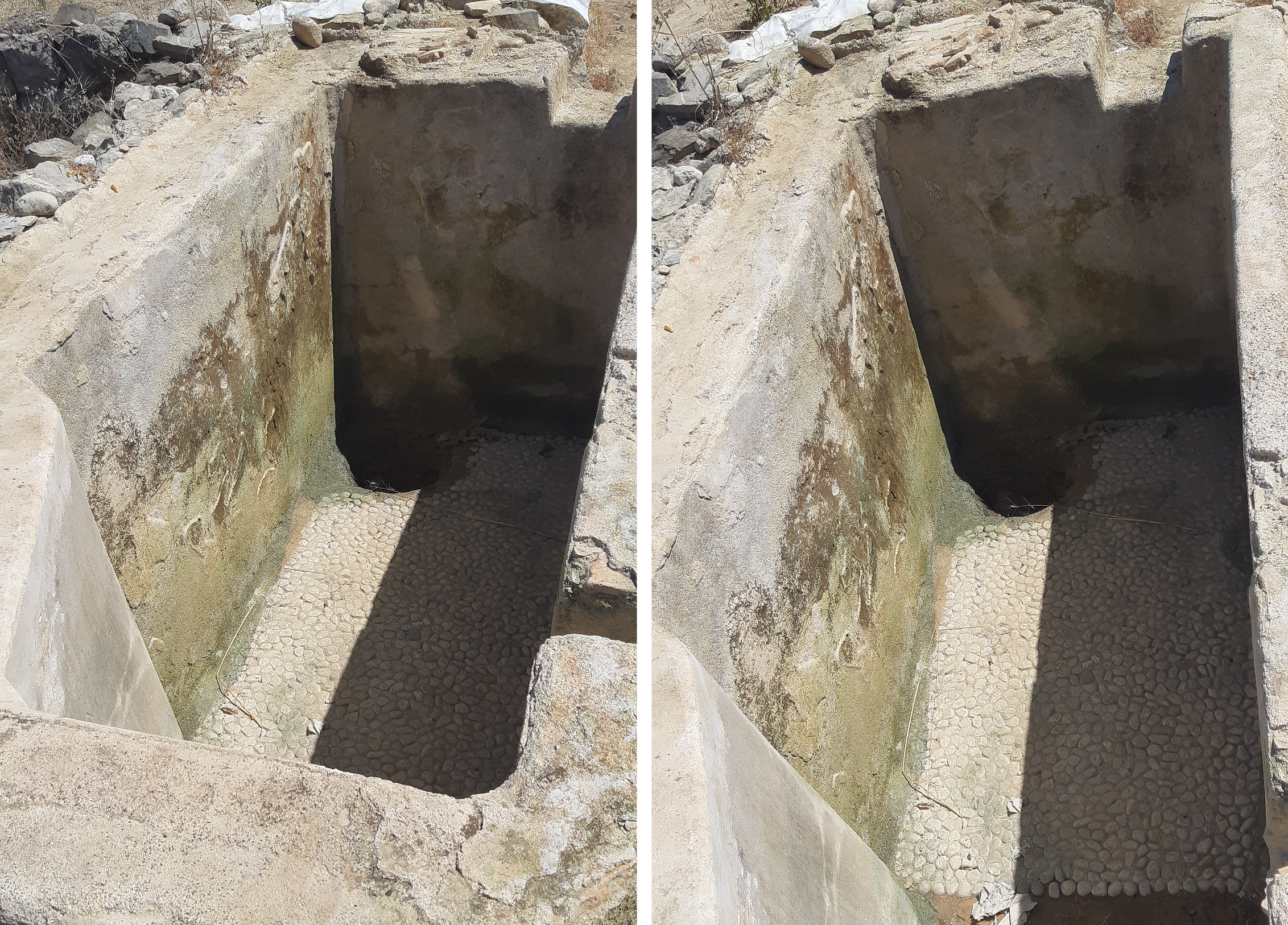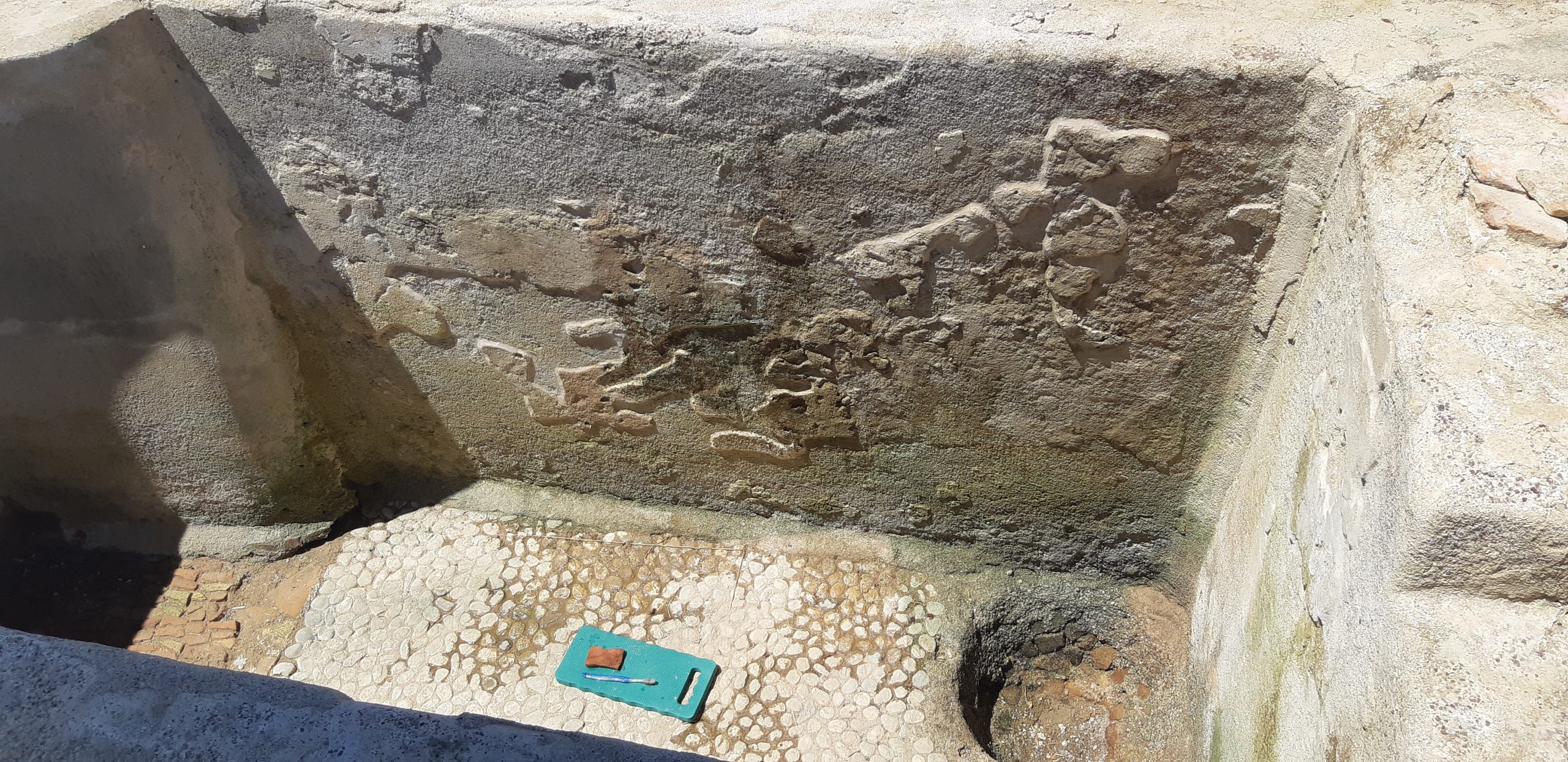The Conservation of Archaeological Stone and the Removal of Mould
25 November 2023Over the summer, I took part in the yearly archaeological excavations at the site of Helike, Greece. This Ancient Greek city was destroyed by an earthquake and a seismic sea wave in 373 BC and has been the primary focus of the Helike Project since 1988. This site is home to the main inspiration of this post, a large basin with pebble flooring that was unearthed in 2004 as part of a Hellenistic dyeing and weaving industrial complex. Unfortunately, upon removing the plastic coverings that were protecting the site during the off-season, we discovered that this basin had developed a mould problem on its stone walls (Figure 1).

Mould is a type of fungi that can be a big problem for conservators, as it is able to grow in a very wide variety of conditions. Steps should ideally be taken to prevent an outbreak, such as maintaining steady temperatures and relative humidity levels to keep conditions out of the optimal levels for mould growth. However, being an outdoor archaeological site, this could receive no such control. The only protection was a sheet of thick plastic, covering the site to protect it from rain and element damage. However, the lack of air circulation that this created would have formed a microclimate inside the basin with a highly fluctuating RH, providing plentiful amounts of what mould requires the most to grow: moisture. If left untreated, these mould spores would produce organic acids that can chemically damage the stone, leading to the degradation of the walls through a process known as biocorrosion.
The steps we took to begin conserving the wall were relatively simple. We found that mechanically cleaning the wall using a toothbrush and some water was more than enough to remove the mould and reveal the grey stone surface below (Figure 2). The only issue with this was that the abrasiveness of the toothbrush could cause the more brittle parts of the wall to flake off. However, with proper care and technique, this damage could be largely avoided.

Should you find yourself in a situation where scrubbing off mould with water isn’t working, there are several further options that could be taken. Chemical cleaning with different substances, such as household bleaches, peroxide bleaches, and hydrochloric acid, will be more effective at removing mould. Bleaches have a high reactivity against organic compounds and are able to destroy proteins and break down organic matter. However, these should be heavily diluted with water. Bleaches often contain soluble salts, which can react with the stone below, forming crystals and causing salt damage if too high of a concentration is used. Similarly, they may also alter the colour of the stone beneath. The use of hydrochloric acids should only be considered as a last resort. While they will be very effective in removing the mould, they can also dissolve the stone to an even greater extent than the mould alone would.
When choosing what chemicals to use when removing the mould, always make sure to consider how they will affect the substance beneath, and not just the mould itself. We chose not to use any additional substances alongside the water when cleaning these walls as:
- The water alone was effectively removing the mould
- The addition of chemical cleaners available at the site, primarily just soaps, would have formed an insoluble yellow-grey film over the surface of the stones, that would have been very difficult to remove.
If water is not enough to restore your site to its mould-free state, then consider testing the use of bleaches that are heavily diluted in water. Depending on the extent of the mould and the type of surface you are working with, different concentrations of bleach or acid may be required when making your cleaning solution. Test these solutions on small parts of the stone to see the extent of cleaning, and any problems they may cause before you continue cleaning the rest of the wall.
Don’t just consider the safety of what you are cleaning, but consider your own safety as well. Remember, mould can be a dangerous substance to work around. Spores that become airborne can be inhaled, affecting health in three main ways: allergy, infection and toxicity. Allergic reactions to these spores are the most common issues, usually resulting in eye and throat irritations, and can worsen asthmatic conditions. Some moulds are pathogenic or are able to produce mycotoxins that are very dangerous to human health. There is a very wide variety of mycotoxins that could be produced, and each requires very specific circumstances to occur, so they are less of a risk. Nonetheless, it is best to always protect yourself against any possibility of infection, no matter how slim the chances of it occurring may be. To prevent infection, follow the COSHH Regulations for wearing PPE, such as:
- Rubber or nitrile gloves
- A hair covering
- Eye protection
- P1 or P2 face mask
This should certainly be worn if dealing with mould in an indoor, enclosed environment.
Useful further reading for more information:
This book is helpful for many conservation basics, including the different cleaning methods and the effects that they might have:
- Cushman, M. (1992). The Science for Conservators Series: Volume 2, London: Routledge.
These provide a useful insight into the conditions mould requires to form, some advice on how to prevent this, and the damage that it is able to cause to surfaces in more scientific detail:
- Guild, S. and Macdonald, M. (2020). Mould Prevention and Collection Recovery: Guidelines for Heritage Collections – Technical Bulletin 26, Ottawa: Canadian Conservation Institute.
- Gutarowska, B. (2014) “Moulds in biodeterioration of technical materials”, Acta Universitatis Lodziensis. Folia Biologica et Oecologica, Vol. 10, pp. 27–39. doi: https://doi.org/10.2478/fobio-2014-0012
These provide more detail on the dangerous health effects that mould can have, and offer ways to protect yourself against them:
- Singh, J. (2005). “Toxic Moulds and Indoor Air Quality”, Indoor and Built Environment, Vol. 14, Issue 3-4, pp. 229-234.
- Better Health. (2020). Mould Removal at Home [online]. Available from: https://www.betterhealth.vic.gov.au/health/conditionsandtreatments/mould-removal-at-home#steps-for-mould-removal-at-home [accessed: 20th November 2023].
- South East Museum Development. (2021). Mould on Historic Collections [online]. Available at: https://southeastmuseums.org/wp-content/uploads/2022/07/Mould-on-Historic-Collections-January-2021.pdf [accessed: 20th November 2023].
The aforementioned COSHH regulations for dealing with mould in the workplace:
- Museum of London. (2019). Hazards in Collections: Mould [online]. Available at: https://hazardsincollections.org.uk/mould/the-law#:~:text=COSHH%20requires%20employers%20to%20reduce,see%20Why%20is%20it%20hazardous%3F) [accessed: 20th November 2023].
For more on the Helike Project:
- Katsonopolou, D and Soter, S. (2005). Discoveries at Ancient Helike [online]. Available from: http://www.helike.org/paper.shtml#fig3 [accessed: 19th November 2023].
This article article provides more insight into removing mould specifically from stone:
- Cornish Lime. (2023). A Guide to Cleaning Rendered Walls, Stone Masonry & Brickwork [online]. Available at: https://cornishlime.co.uk/articles/a-guide-to-cleaning-rendered-walls-stone-masonry-amp-brickwork/#:~:text=Fungi%2C%20mould%2C%20algae%20and%20lichens,such%20as%20slate%20and%20sandstone [accessed: 20th November 2023]
- March 2024 (1)
- December 2023 (1)
- November 2023 (2)
- March 2023 (2)
- January 2023 (6)
- November 2022 (1)
- October 2022 (1)
- June 2022 (6)
- January 2022 (8)
- March 2021 (2)
- January 2021 (3)
- June 2020 (1)
- May 2020 (1)
- April 2020 (1)
- March 2020 (4)
- February 2020 (3)
- January 2020 (5)
- November 2019 (1)
- October 2019 (1)
- June 2019 (1)
- April 2019 (2)
- March 2019 (1)
- January 2019 (1)
- August 2018 (2)
- July 2018 (5)
- June 2018 (2)
- May 2018 (3)
- March 2018 (1)
- February 2018 (3)
- January 2018 (1)
- December 2017 (1)
- October 2017 (4)
- September 2017 (1)
- August 2017 (2)
- July 2017 (1)
- June 2017 (3)
- May 2017 (1)
- March 2017 (2)
- February 2017 (1)
- January 2017 (5)
- December 2016 (2)
- November 2016 (2)
- June 2016 (1)
- March 2016 (1)
- December 2015 (1)
- July 2014 (1)
- February 2014 (1)
- January 2014 (4)